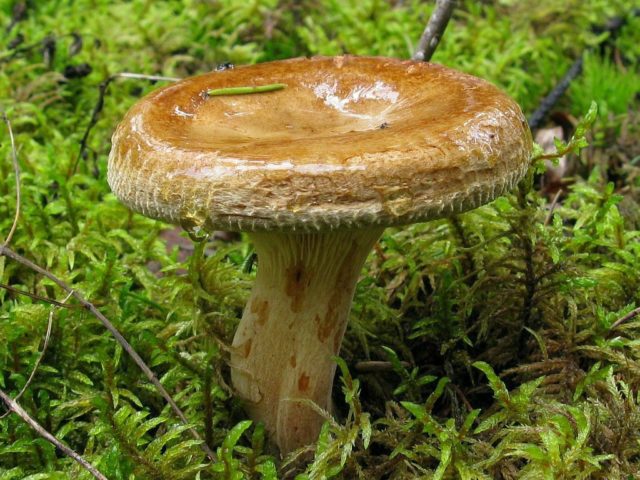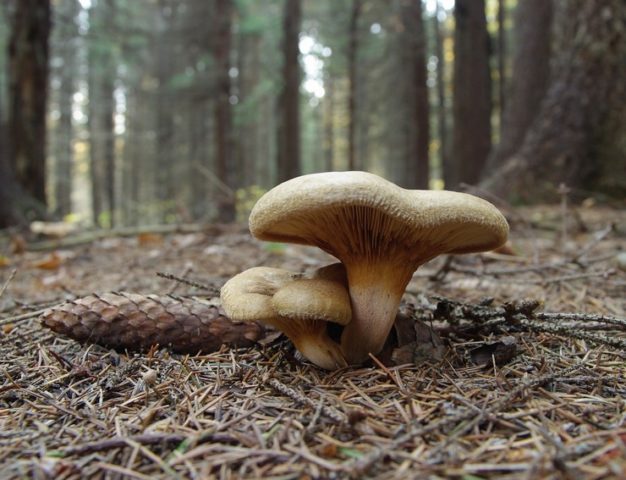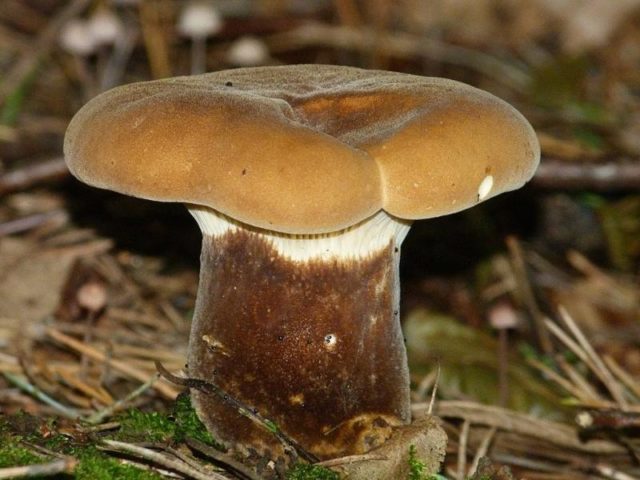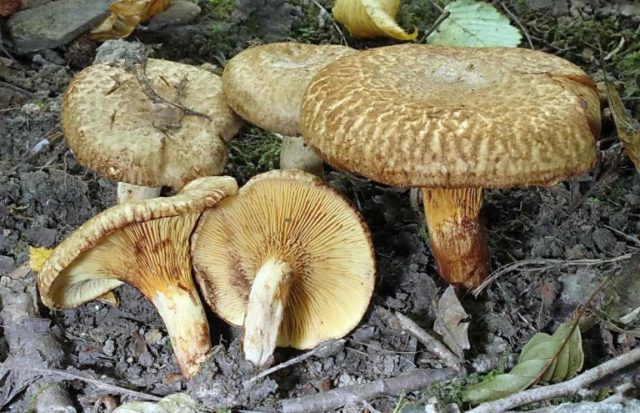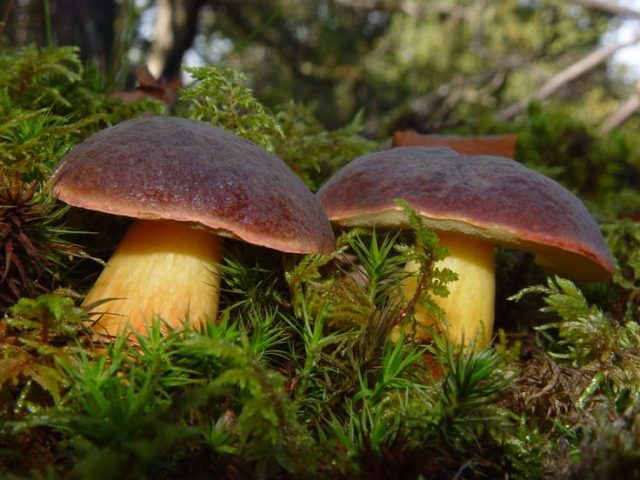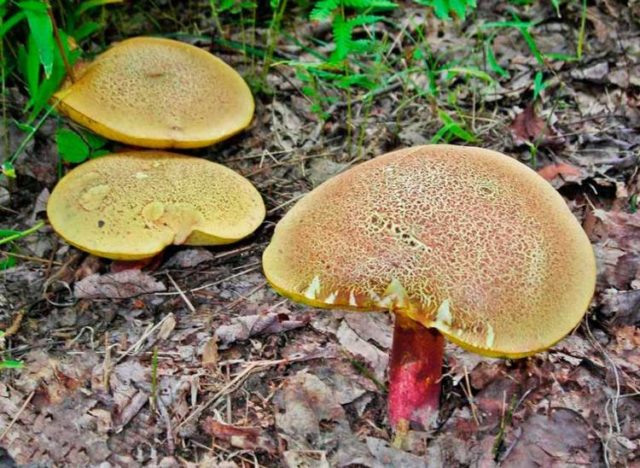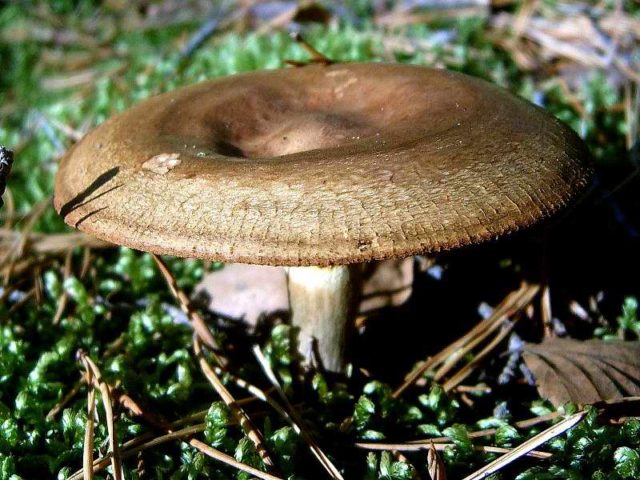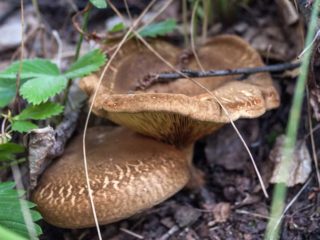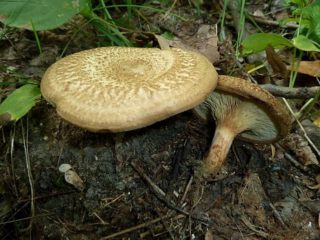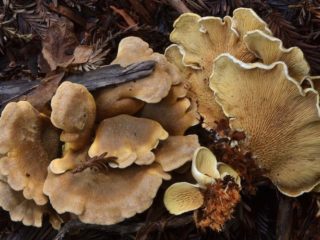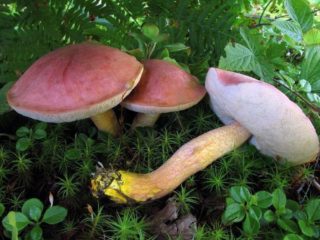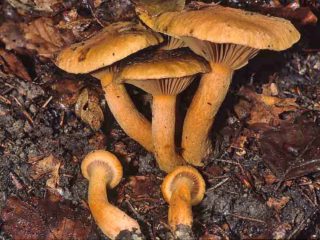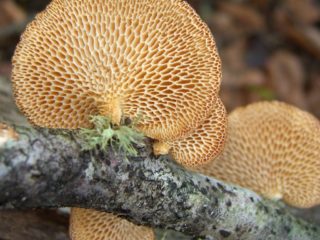Content
The slender pig is an interesting mushroom, the edibility of which is still hotly debated. Some believe that after processing it can be consumed, others attribute the pig to poisonous mushrooms. To figure it out, you need to study the features of the species.
What does a piggy look like?
The mushroom, which is also called dunka, pork ear, pork and cowshed, can be recognized by its wide fleshy cap, reaching 15 cm wide in adulthood. A photo and description of a slender pig report that in young slender pigs, the cap is slightly convex, but gradually becomes flat and acquires a funnel-shaped depressed depression in the center. The edges of the cap are velvety, tightly wrapped. The color of a slender pig depends on age - young specimens are usually olive-brown and slightly pubescent, and adults have a reddish, rusty, ocher color. In adult specimens, the cap is shiny and without edge; as it ages, the color begins to fade.
The underside of the cap is covered with wide thin plates going down the stem. The plates are quite rare, they can close together, forming a mesh, and are ocher-yellow in color. The leg of a slender pig can rise up to 9 cm above the ground, and in diameter reaches 1.5 cm. In shape, the leg is usually cylindrical with a slight narrowing in the lower part, with a dense structure.
The flesh on the cut is loose and soft, yellowish in color, quickly turns brown in the air. A fresh thin pig does not have a specific smell and taste, which is why many mushroom pickers mistakenly perceive it as a completely safe forest species.
Description of the thin pig
The slender pig belongs to the Svinushkov family and is widespread throughout Europe and central Russia. It grows in both coniferous and deciduous forests, most often it can be found in birch groves, bushes, on the outskirts of ravines and swamps. The pig is also found in oak forests, on forest edges, under pines and spruces, and in the roots of fallen trees.
The fungus prefers well-moistened soils, and usually grows in large groups - single thin pigs are less common. The peak of fruiting occurs in late summer and early autumn. At the same time, the first pigs can be found in June, and they continue to grow until October.
The pig is thin edible or not
The issue of the edibility of thin pigs is of great interest. Until 1981, the mushroom was considered conditionally edible - it was attributed to the 4th category of edible species, defined as universal, and allowed to salt, pickle and fry.It is for this reason that many mushroom pickers still refuse to "transfer" the mushroom to the category of poisonous, out of habit continuing to put it in a basket.
However, modern science has a very definite opinion. In 1981, the Ministry of Health officially deleted the slender pig from the list of edibles. In 1993, it was classified as a poisonous mushroom and remains there to this day.
The basis for such changes was the results of recent research by scientists-mycologists. In the pulp of a slender pig, toxic substances were found - muscarine, hemolutin and hemolysin. During heat treatment, these compounds are not destroyed or partially destroyed, therefore, over time, they accumulate in the body.
When a thin pig is eaten, at first glance, the body does not receive any harm - provided that the mushrooms are cooked fresh. Instant poisoning does not occur, but the poisonous compounds present in the pulp remain in the blood and tissues. If you eat a slender pig often, then over time, their concentration will increase. The negative effect of toxins will manifest itself in the fact that antibodies will begin to form in the blood, causing the destruction of red blood cells. This process will lead to a drop in hemoglobin levels, and after that - to severe damage to the liver and kidneys. Thus, a person will develop anemia or jaundice, caused by seemingly harmless pigs.
Thus, thin pig mushrooms are categorized as unequivocally inedible; it is not recommended to eat them. If the liver and kidneys of a person are healthy, then from a single use of the mushroom, bad consequences will not come, but with repeated use, the state of health will inevitably deteriorate.
Similar species
There are no frankly dangerous poisonous counterparts in the slender pig. It can be confused mainly with mushrooms of the same type - alder and plump pigs.
The pig is fat
In color and structure, the species are very similar to each other. However, the differences between them are also very noticeable - a fat pig, as the name implies, is somewhat larger. The diameter of the cap of an adult mushroom can reach 20 cm, and the stem usually grows up to 5 cm in diameter.
Contrary to popular belief, the fat species is likewise classified as inedible. It has a similar chemical composition and is harmful to health, so it cannot be used in food.
Alder pig
This rather rare mushroom also resembles a slender pig in its color, size and shape of the leg and cap. But the red color in the alder variety is usually brighter, and in addition, pronounced scales are noticeable on the cap. Mushrooms also differ in places of growth - an alder mushroom grows under aspens and alders, but it is impossible to meet it in random places, like a thin pig.
The alder variety also belongs to the category of poisonous mushrooms, and after its use, intoxication develops very quickly. The concentration of muscarine in the composition is higher than in fly agarics - negative symptoms may appear within half an hour after the mushroom is used in food. It is highly discouraged to confuse an alder pig with a thin one - the consequences can be critical.
Polish mushroom
Sometimes an edible Polish mushroom is mistaken for a slender pig. The similarity lies in size and color, but it is easy to distinguish between them - the Polish mushroom has a convex cap, without a depression in the center, and on the lower side its surface is spongy, not lamellar.
Variegated flywheel
Another edible mushroom, due to inexperience, can be confused with a toxic pig. The variegated flywheel has a fleshy cap on average up to 10 cm in diameter, with its light brown color it can look like a thin pig.But the cap of the mushroom, regardless of age, remains flattened-convex - a depression does not appear in its center. In addition, on the underside of the cap are not plates, but thin tubes.
Application
Official science and the Ministry of Health quite unequivocally classify the slender pig as poisonous mushrooms and prohibit eating it. But, despite this, some mushroom pickers adhere to their opinion and continue to believe that in small quantities the species is safe for health. However, even they follow certain strict rules in application:
- In its raw form, a thin pig is never consumed - a fresh specimen contains the maximum amount of toxic compounds and causes the greatest harm to health.
- Before use, the mushroom is soaked in salt water for at least 3 days. In this case, every few hours the water needs to be changed to fresh.
- After soaking, the thin pig is thoroughly boiled in salt water, it must also be replaced until it stops darkening and turns light.
For food use, the mushroom is usually salted - salt additionally reduces the concentration of harmful substances in the pulp. It should not be fried, dried and marinated; the gifts of the forest should not be accepted immediately after boiling without additional processing.
What to do if you ate a thin pig
The toxins in the poisonous mushroom thin pig act on the human body individually. Immediately after knowingly or accidentally using the mushroom, some people feel normal, while others quickly notice a deterioration in well-being. Poisoning can occur in a short time and for the reason that the pulp of this mushroom very well accumulates heavy metals and radioisotopes. If mushrooms are collected in a contaminated area, then the concentration of toxic substances in them will be 2 times higher than in the soil.
Intoxication after eating the mushroom is manifested by traditional symptoms, which include:
- abdominal pain;
- diarrhea and severe nausea;
- fever and fever;
- lowering blood pressure.
In case of signs of acute poisoning, it is necessary to urgently call a doctor, and before his arrival, drink more water and try to induce vomiting - in this case, some of the toxic substances will leave the body.
The situation is more complicated with the elimination of long-term consequences from the use of an inedible mushroom. In fact, it is not possible to remove toxic substances from the body, otherwise this species would not be considered such a dangerous product. First of all, it is recommended to take laboratory tests from time to time and monitor the number of red blood cells and the level of hemoglobin in the blood.
With a decrease in important indicators, it is recommended to consult a doctor so that he can prescribe a therapeutic treatment. Usually, when the blood composition deteriorates, antihistamines are used to reduce the severity of the body's autoimmune reaction. In severe cases, steroid hormones are used, they slow down the process of destruction of red blood cells, and the severity of negative consequences decreases.
Therefore, when collecting and processing mushrooms, you need to very carefully determine their species and try not to confuse an inedible mushroom with similar species.
Conclusion
The slender pig is an inedible mushroom with rather insidious properties. The consequences of poisoning with it do not appear immediately, but are very serious, so it is not recommended to neglect them.
